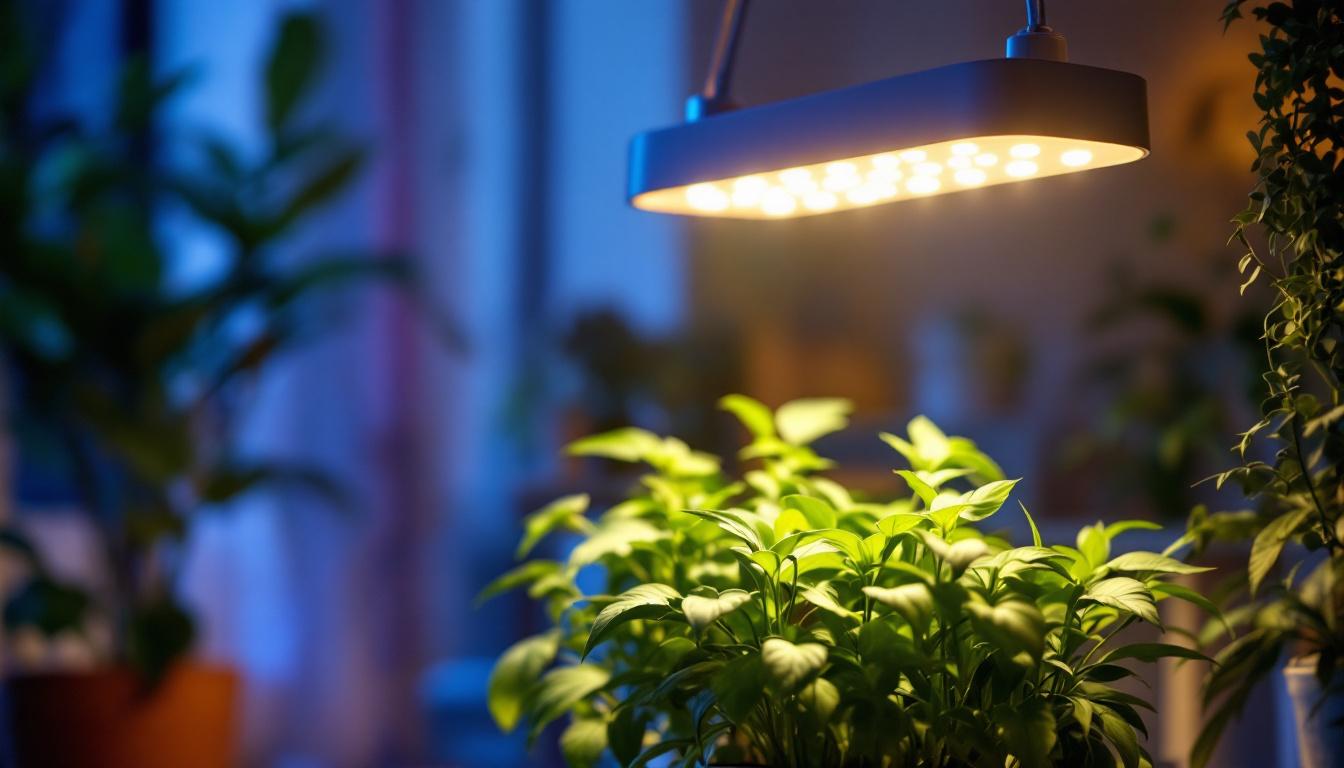
In the rapidly evolving world of horticulture and indoor gardening, grow lights have emerged as a pivotal component for success. For lighting contractors, understanding the significance of shop grow lights is not just beneficial; it is essential. These specialized lighting systems play a crucial role in enhancing plant growth, optimizing energy efficiency, and ensuring client satisfaction. This article delves into the importance of grow lights for lighting contractors, exploring their functionality, benefits, and the factors to consider when selecting the right products.
Grow lights are designed to provide the specific light spectrum that plants need for photosynthesis. Unlike traditional lighting, which may not offer the right wavelengths, grow lights emit light in a manner that mimics natural sunlight. This functionality is vital for indoor gardening, where natural light may be limited or inconsistent. By utilizing grow lights, gardeners can create an optimal environment for plant growth, ensuring that their green companions receive the necessary light to flourish regardless of external weather conditions.
Photosynthesis is the process through which plants convert light energy into chemical energy, allowing them to grow and thrive. The light spectrum plays a significant role in this process. Grow lights typically offer a combination of blue, red, and sometimes green light, which are essential for different stages of plant growth. Blue light promotes vegetative growth, while red light encourages flowering and fruiting. Understanding the nuances of light wavelengths can significantly impact the overall health and yield of plants, making it crucial for gardeners to select the right type of grow light for their specific needs.
By understanding the specific light requirements of various plants, lighting contractors can recommend the most suitable grow lights to their clients. This knowledge not only enhances plant health but also boosts client confidence in the contractor’s expertise. Furthermore, the ability to adjust light intensity and duration can lead to more controlled growth cycles, allowing gardeners to synchronize flowering times or extend the growing season well beyond the natural limits imposed by seasonal changes.
There are several types of grow lights available in the market, each with its unique advantages and disadvantages. The most common types include LED, fluorescent, and high-intensity discharge (HID) lights. Each type caters to different gardening setups, from small home gardens to expansive commercial operations.
LED grow lights are gaining popularity due to their energy efficiency and longevity. They produce less heat, reducing the risk of overheating plants and minimizing cooling costs. Additionally, many LED models come with adjustable spectrums, allowing growers to customize the light output for various plant stages. Fluorescent lights, on the other hand, are often used for seedlings and young plants due to their lower intensity. They are also relatively inexpensive and easy to set up, making them a favorite among novice gardeners. HID lights, including metal halide and high-pressure sodium, are powerful options for larger growing areas but require careful handling due to their heat output. These lights are particularly effective in commercial settings where maximizing yield is a priority, as they can cover large areas and penetrate deep into plant canopies, ensuring that even lower leaves receive adequate light exposure.
For lighting contractors, offering grow lights as part of their product range can lead to numerous benefits. These advantages not only enhance the contractor’s service portfolio but also contribute positively to their business growth.
The trend of indoor gardening has seen a significant rise, particularly in urban areas where outdoor space is limited. As more individuals and businesses seek to cultivate plants indoors, the demand for effective grow lights has surged. Lighting contractors who can provide tailored solutions to meet these needs are well-positioned to capture this growing market.
By integrating grow lights into their offerings, contractors can cater to a diverse clientele, including hobbyists, commercial growers, and even educational institutions. This diversification can lead to increased sales and stronger client relationships.
One of the primary concerns for both contractors and their clients is energy consumption. Grow lights, particularly LED options, are designed to be energy-efficient, providing significant cost savings over time. By promoting energy-efficient lighting solutions, contractors can help clients reduce their electricity bills while also contributing to environmental sustainability.
Moreover, many modern grow lights come with features such as dimmable settings and programmable timers, allowing for even greater control over energy usage. By educating clients on these features, contractors can enhance their value proposition and foster long-term relationships.
When selecting grow lights, lighting contractors must consider several factors to ensure they provide the best solutions for their clients. Understanding these considerations can lead to more informed recommendations and ultimately, higher customer satisfaction.
Different plants have varying light requirements based on their species and growth stages. For instance, leafy greens may thrive under blue light, while fruiting plants require more red light. Contractors should assess the specific needs of their clients’ plants to recommend the most suitable grow lights.
Additionally, understanding the growth stage is crucial. Seedlings and young plants may require different light intensities compared to mature plants. By tailoring recommendations to the specific plants and their growth stages, contractors can ensure optimal results.
The available space for indoor gardening can greatly influence the choice of grow lights. Lighting contractors should evaluate the size and layout of the growing area, as this will determine the type and number of lights needed. For smaller spaces, compact LED lights may be ideal, while larger areas may require more extensive lighting setups.
Furthermore, the layout of the growing area can affect light distribution. Contractors should consider how to position grow lights to ensure even coverage, minimizing shadows and maximizing light exposure for all plants.
Proper installation and maintenance of grow lights are critical for their performance and longevity. Lighting contractors play a vital role in ensuring that clients understand the best practices for both installation and ongoing maintenance.
When installing grow lights, contractors should follow manufacturer guidelines to ensure optimal performance. This includes proper mounting height, angle, and distance from plants. Additionally, ensuring adequate electrical supply and safety measures is essential to prevent any hazards.
Contractors should also educate clients on the importance of adjusting light heights as plants grow. As plants reach towards the light, the distance between the light source and the plant canopy may need to be adjusted to prevent burning or stunted growth.
Regular maintenance of grow lights is essential for their efficiency and effectiveness. Contractors should advise clients on routine checks, such as cleaning light fixtures to remove dust and debris that can block light output. Additionally, monitoring the performance of the lights and replacing any faulty components is crucial for maintaining optimal growing conditions.
In the event of issues, contractors should be prepared to troubleshoot common problems. This may include addressing flickering lights, inadequate light intensity, or issues with timers and controllers. Providing ongoing support can enhance client satisfaction and establish the contractor as a trusted expert in the field.
The horticultural industry is continuously evolving, with advancements in technology leading to more efficient and effective grow light solutions. Lighting contractors must stay informed about these developments to remain competitive and provide the best options for their clients.
Recent innovations in grow light technology have led to the development of smart lighting systems that can be controlled remotely via smartphones or computers. These systems allow for precise control over light intensity, spectrum, and duration, enabling growers to tailor their lighting conditions to the specific needs of their plants.
Additionally, advancements in light-emitting diode (LED) technology have resulted in more powerful and efficient lights that can cover larger areas with less energy consumption. Contractors who stay abreast of these innovations can offer cutting-edge solutions that set them apart from competitors.
As sustainability becomes increasingly important in all industries, the horticultural sector is no exception. Grow lights that utilize renewable energy sources or are made from recyclable materials are gaining traction. Lighting contractors can enhance their offerings by promoting environmentally friendly options, appealing to eco-conscious clients.
Furthermore, integrating grow lights with other sustainable practices, such as hydroponics or aquaponics, can provide clients with comprehensive solutions that maximize efficiency and productivity. By positioning themselves as leaders in sustainable horticultural practices, contractors can attract a dedicated customer base.
In conclusion, shop grow lights are an essential component for lighting contractors looking to thrive in the indoor gardening market. By understanding their functionality, benefits, and the factors to consider when selecting and installing grow lights, contractors can provide valuable solutions that meet the diverse needs of their clients.
As the demand for indoor gardening continues to rise, lighting contractors who embrace the importance of grow lights will not only enhance their service offerings but also contribute positively to the success of their clients. By staying informed about technological advancements and sustainable practices, contractors can position themselves as trusted experts in the field, ensuring long-term success in an ever-evolving industry.
Ready to elevate your lighting game and meet the growing demands of indoor gardening? Look no further than LumenWholesale for a comprehensive range of high-quality grow lights. Our spec-grade products are designed to ensure that you can offer your clients the best in energy efficiency and plant performance. With unbeatable wholesale prices and the convenience of free shipping on bulk orders, you can trust LumenWholesale to provide premium lighting solutions that fit your budget. Don’t let middleman markups dim your business potential. Choose LumenWholesale for Wholesale Lighting at the Best Value and brighten your projects today.

Discover essential plant light fixtures for lighting contractors—boost efficiency, ensure optimal plant growth, and stay ahead with expert insights.

Discover the ultimate guide for lighting professionals with “Leds On: The Essential Checklist.” This comprehensive article covers everything from selecting the right LEDs to optimizing lighting design for any project.

Discover the essentials of Lumens flush mount lighting with our comprehensive guide tailored for lighting contractors.

Discover the essential insights lighting contractors need to meet client expectations for garage lighting.